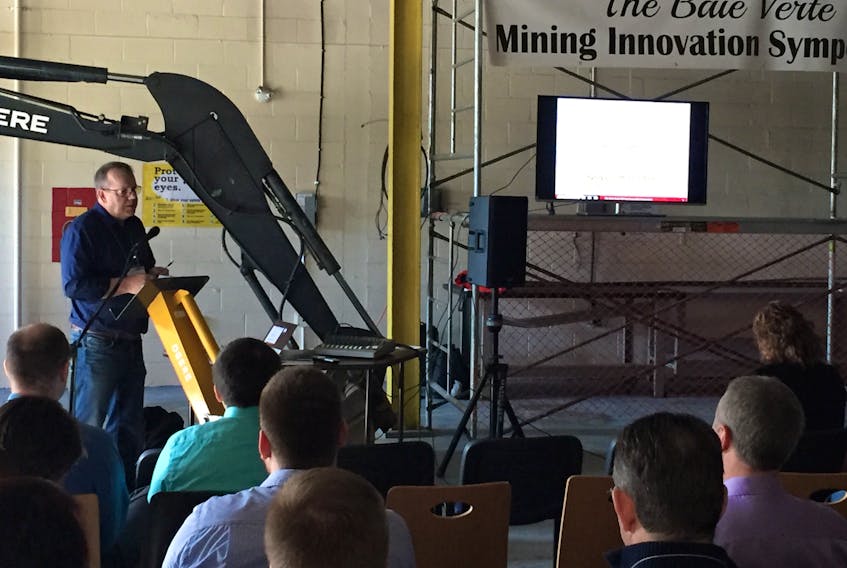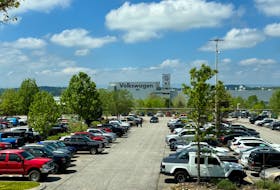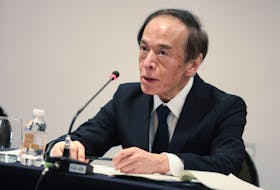BAIE VERTE, NL - When all three mining producers on the Baie Verte Peninsula came together with academic researchers and industry supporters last week, a new level of innovation was reached.
Representatives of Anaconda Mining, Rambler Metals and Mining, and Guy J. Bailey gathered at the two-day Baie Verte Mining Innovation Symposium.
They had a chance to meet, together and separately, with Memorial University researchers from both the St. John's and Grenfell campuses and College of the North Atlantic academia as well as with support organizations such as the Atlantic Canadian Opportunities Agency (ACOA) and Research Data Canada (RDC).
Allan Cramm, vice president of innovation and development with Anaconda, is a promotor of the Baie Verte Peninsula as a whole. He believes the common goal of the mining sector to improve the industry in the region is beneficial for all.
"As much as it is important to us as a company, it is really important to us as a region," he said. "It is in our collective interest for all of us to do well - for Rambler, Guy J. Bailey and Anaconda to do well - because the three of us are operating here. When you have three mines operating as producers, you have a mining district. When you have only one mine operating, it is just one mine operating."
Cramm hopes the symposium leads to an increased interest in mining innovation within the research community.
The "bring science to the site" mentality led to the makeshift mining site set up at the symposium location at the College of the North Atlantic in Baie Verte. Speakers delivered their messages next to a grader or excavator, and nearby there was some scaffolding set up.
"It was all set up to simulate an industrial site, a mine site," he said. "It created a different ambiance, saying it is on our turf."
Guy J. Bailey
Scott Bailey of Guy J. Bailey has operated his company for about 50 years, growing it from a small to a medium-sized business with the addition of Shoreline Aggregates.
A small company does not always have the expertise to deal with such expansion, so a symposium such as this one gave him an opportunity to learn about assistance available for them to develop their business.
"We haven't had a lot of government support over the years," he said. "It has kind of been a stand-alone company that has always been self-supported. We have never had the resources to go out looking for funding. It's not like we are looking for handouts, it is just sometimes about having that expertise there and the support to bring those people in.
"That helps get industry kick started, and makes it that much better for everybody."
As the area's primary contractor, Guy J. Bailey has always been active. However, he said the mining industry now offers many more opportunities.
"It is important for us to have the right people to facilitate the jobs," Bailey said. "In our organization, we may be lacking engineering and project management, and some of these people may be hard to attract because we are in rural Newfoundland. It is not easy to get them to come here and work."

Rambler Metals and Mining
Sean Breen of Rambler Metals and Mining said the symposium was a great way to meet the people involved in the mining industry as well as those in academia and the support organizations.
"We are always looking to improve things like ore definition," he said, and there were people at the symposium who were able to tell them about different technologies available to help with that.
"We are hoping we can develop a project or two with somebody like MUN," Breen said.
He felt each company's representatives were genuine in their intent to help the mining industry grow in the region.
"You get a chance to discuss common problem, and possibly collaborate to help each other out," he said. "We are not in direct competition, so why not help each other out.
"As long as we have two mines here, and we can keep them open and employing people, everybody benefits."
Memorial University of Newfoundland (MUN)
Ken Carter, director of engagement at Grenfell Campus of Memorial University of Newfoundland, appreciated the opportunity to tour the mining sites to get a greater appreciation for the work and the opportunities for research.
He felt the symposium was highly effective in its attempt to create interest.
"You had all the right players in the room - you had industry, you had government, you the university as well as the College of the North Atlantic," Carter said. "Bringing all those partners together, and having funding agencies and community partners there, had an incredible synergy amongst all of us.
"In rural places in particular, our only way forward is to bring that kind of collaboration together and to find ways to make things work."
Of particular interest to Grenfell and its team of researchers, Carter says, are synergies around mine waste with forestry and agriculture. He said there must be effort on scientific testing and that's where the Boreal Ecosystem Research Initiative (BERI) laboratory facility can play a role.
"There is already some work going on between the educational institutions and the mines, particularly with Anaconda, but we are finding new ways and new possibilities the more we talk," Carter said. "We need those kind of forward-thinking companies to find ways of connecting to the university and the (College), and ... between the three institutions there are about 1,700 faculty members, so we need to align our work more closely with community and industry needs."
Cramm feels the symposium was a success, and should be an annual event.
He is already considering a more specific approach to future events, with possibly a focus on exploration research or processing innovation.
He also believes the same symposium concept can be applied to other sectors -focusing on the fishing industry for example.









